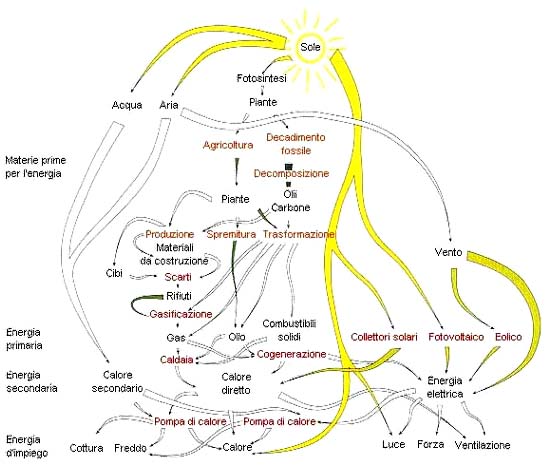|

The sun is the energy source that nourishes life on earth, gives life to plants which become food for animals, and through the differences in temperature gives origin to winds, rain, waves.
Man has adapted his lifestyle to the sun cycles.To cope with the discontinuity of the sun irradiation, in the past men used to migrate in search of warmer climates.
The most important invention in the history of humanity has been the discovery of fire, though the combustion of wood.
Fire gives light when it's dark and heat when it's cold, protects from predating animals, allows cooking foods.
In the course of evolution man has continued to develop the techniques of combustion, learning to cook clay and fuse metals, thus producting more and more sophisticated
tools.
Wood still remained the most used raw material.
The most important deforestation occurred in the centuries between the first and second millennium and produced a permanent ecological damage on entire regions of the earth.
Until the eighteenth century the only forms of mechanical energy used were wind and water (thanks to mills).
With the invention of the steam engine it became possible to obtain energy by burning wood.
The need for more and more quantities of fuel drove man to use the non renewable resources of the earth (carbon, oil, etc.) which had been stored for millions of years in the subsoil and were deemed infinite.
On the use of these sources of energy the Industrial Revolution was built.
The progressive improvement of combustion techniques allowed man to get big quantities of energy in constant fashion.
This allowed creating in buildings an artificial comfort without depending on the discontinuous cycle of the sun.
In this way man and architecture have started to get away from nature without realizing it.
The combustion of non renewable energetic resources also introduced another problem: pollution.
The combustion of wood or biomasses, on the contrary, causes a reduced environmental pollution (essentially CO2 - Carbon dioxide) which can be neutralized through new
plantings.
Wood was substitued also as a building material, replaced with concrete, steel, aluminium, plastic, etc. , apparently more efficient and inexhaustible materials.
Not using wood was thought to be contributing to the protection fo the environment, while in fact the latter began to be more seriously damaged.
The production and processing of the new building materials require a much higher consumption of energy, called production energy.
The non renewable energy sources also require more energy in the production, transport and distribution processes.
The sum of these losses in transformation is called grey energy.
In the course of its life, wood collects and stores energy and CO2, requires little production energy as a building material and costs little grey energy if used as
fuel.
A cubic metre of wood absorbs 1,000 Kg of Carbon Dioxide (CO2) during its growth; after about 50 years a tree constitues a good stock of Carbon but once this is finished it starts absorbing less and less CO2 and producing less Oxygen (O2).
Besides, it becomes more vulnerable to insects and fungus and subject to easy breaking, its function as a biological collector becomes more and more restricted, so a tree which is no longer efficient must be cut.
From the energetic point of view a cubic metre of wood can be converted into 2500 kWh of energy, while if used as a building material about 75 % of it can be cut in square woodplanks, the remaining 25% of waste can be used as fuel to get 625
kWh.
In order to cut, transport, saw, plane, etc. 1 cubic metre of wood it takes about 660 kWh of energy, of which 200 kWh for the mechanical process, the rest is used thermically for drying, this means that by using the energy contained in waste to feed the production and processing, the energy balance is almost even.
If then you consider that most of the drying process can be done by using solar technologies, the balance becomes active.
Once used as a building material it has a lifespan which varies from a few years to many centuries during which it does not lose its energy content; when it has to be removed and replaced it must be considered as a hidden stock of energy capital.
This means that it's the ideal material for sparing energy and reducing
pollution.
|